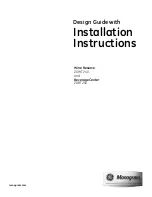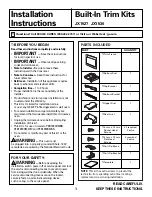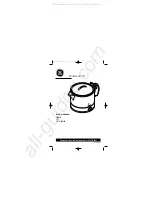
38
• Check the bag for damage or holes. Padding out sharp edges of the contents using kitchen paper is
recommended.
Appliance does not create a complete vacuum inside a container
• Check if one end of the connection hose is positioned into the hose port of the appliance and the other
end into the knob of the container’s lid.
• Do not fill the container completely but leave a space above of at least 3 cm.
• Remember that liquids must be allowed to cool (in the fridge to be sure) before being vacuum-sealed.
• Check if the upper rim of the container or jar as well as the seal of the universal lid is undamaged and
clean. Clean the rim and the lid with a tepid moist cloth and start the vacuum-sealing process again.
• Ensure that the seals of the lids on the container or universal lids fit correctly and are undamaged.
“Executive” containers or universal lids lose their vacuum
• Check whether the arrow on the knob of the lid of the container and universal lid were turned to
“CLOSED” after the vacuum-sealing process.
• Check whether the rim of the container/jar and the seal of the universal lid are undamaged and clean.
Clean them with a moist cloth and start vacuum-sealing anew.
• Check the right fitting and intactness of all seals in the lids of containers and universal lids.
• Make sure that the ring below the knob of the lid of the container/the universal lid fits exactly.
• Check the correct connection of the hose with appliance and lid.
Marinating cycle does not start
• Check whether the rim of the container is undamaged and clean. Clean it with a moist cloth and start
vacuum-sealing anew.
• Check if the gaskets in the container’s lid fit correctly and if they are undamaged.
• Look to see if the ring under the knob of the lid of the container is positioned correctly and fits exactly.
• During the first vacuuming cycle press the lid slightly on the container until the status indication (2C)
displays the first operation step and lights up correspondingly.
Vacuum-sealing - general information
Advantages of vacuum-sealing
• Vacuum-sealing will revolutionise the way in which you buy and keep food. By keeping food under
vacuum (i. e. without air), the shelf-life of foods is greatly extended, whether it is kept in the pantry,
fridge or freezer. Air can make food rancid and stale, it can cause it to ferment, dry out, and it may even
cause freezer burns. Vacuum-sealing keeps your food fresher and more flavourful for longer.
• Now you can pack fresh food bought from the market, or food picked from your vegetable garden, in
handy portions for future use, even in large quantities. Food bought already vacuum-sealed, like cheese
and meat, will retain its flavour and freshness once opened, without problems of moisture and mould,
if it is vacuum-sealed after use in Rommelsbacher Magic Vac
®
bags and containers. Meat, fish and
vegetables can be frozen without the risk of freezer burns and will keep their freshness and quality.
Foodstuffs like coffee, rice, flour and dried fruit will last much longer if they are vacuum-sealed with
your vacuum sealer. Fresh or perishable foods must in any case be frozen or kept in the fridge.
• The original quality of the food must be of the very highest order, in terms of freshness and
environmental hygiene, when you decide to vacuum-seal it. There are in fact no preservation methods
which will transform a poor product into a good one.
• Always keep your vacuum sealer, bags and containers handy and you will quickly appreciate the many
advantages and ease of use when it comes to preserving the quality of food.







































